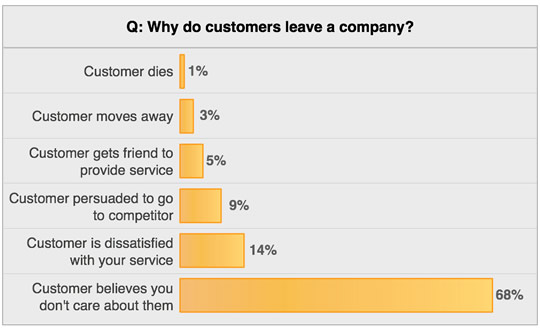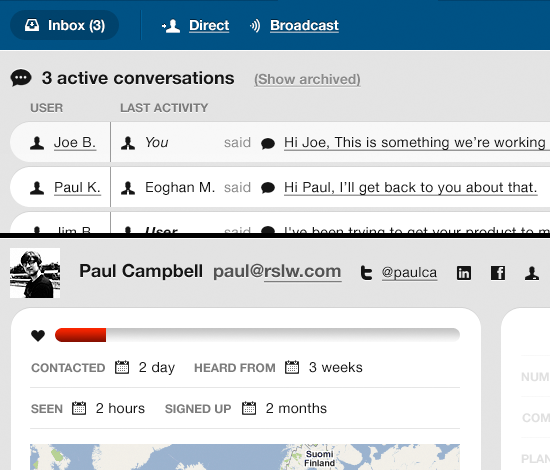Taking A Customer From Like To Love: The UX Of Long-Term Relationships
“What do you mean ‘improve’? I charged him correctly, didn’t I?.”
My manager looked at me, disappointed:
“Yes, Des, you charged him correctly. But a vending machine can do that, too. They show up on time; they’re more accurate; I don’t pay them by the hour; and they’re never hungover. Your job is to do something that a vending machine can’t do. Your job is to make our customers happy; give them a good experience; bring them back here again. Get it?”
I started to wonder. This was a gas station; how could I deliver a “good experience”? Surely, customers just want to get in and get out. Nonetheless, if I wanted to keep the job, I’d have to try. I started chatting to customers and casually asking questions. Did they find everything they needed. Could we order in a particular newspaper for them?
Do they have our phone number in case they need to check whether we carry something? Why did they stop buying from the bakery? Customers regard gasoline as a cost that they have no say about. They enter the store annoyed at having to spend fifty bucks. My job was to change that. I got it.
MBAs call this “customer experience,” although when it’s spelled out so plainly, it sounds more like common sense. And like most common sense, it’s rarely that common — especially in the world of subscription software, where we need customers to stick around.
User experience designers are great at making software friendly and usable for new customers. We design clean, clear sign-up forms, smooth on-boarding experiences, and even helpful blank slates once users are inside the app. Once customers have used the software for some time and have integrated it in their workflow, their relationship with the software becomes more complex. UX designers have no stencils for designing “how the customer feels about the software after six months.” This matters because the software-as-a-service (SaaS) model depends on loyalty, on the idea that customers won’t flinch when they see your monthly charge.
Competing On Service
Initially, all markets compete on price. However, competing on price simply isn’t relevant with Web apps, because they are all in the same $0 to $99 per month bracket. Think about it: what sane person would switch project management tools just to shave ten bucks off their monthly costs?
We have reached the point where the service part of SaaS is most relevant, the point where the experience your customers have with your company will determine whether they stick or switch. Say you’ve been paying $50 a month for your time-tracker for the last three years. Have you enjoyed the service? Have you ever been personally thanked for your loyalty? Do you feel that the provider values your $1,800?
Customers Who Don’t Feel Valued Leave
The Rockefeller Corporation studied why customers leave one company for a competitor and found the following:

Look at what’s not here. No mention of price or quality. How you make customers feel is what drives their loyalty, and it’s here where website owners are in trouble. Website owners are disconnected from their customers, save for a conference party or survey each year. If you asked them to introduce you to 10 of their customers, most would struggle, grimace and then get a developer to break out the SQL. Imagine trying to run a bar, convenience store, hair salon — heck, any service — with that level of apathy towards the folks who pay your wages. It shouldn’t be surprising that your customers are willing to jump ship the second a competitor launches a sexy iPhone app. If you’ve never cared about your customers, why would they care about you?
Warren Buffett talks about building a moat around your business to make it untouchable. The strongest moat you can build is one based on strong relationships. Low prices can always be beaten. Stunning design ages quickly and can easily be copied. Impeccable uptime can be matched, and your features copied. However, a good customer relationship is unique, and loyal customers are hard to steal.
Some Things You Can’t Wireframe
Wireframes and mock-ups are excellent for figuring out and discussing screen layout. You can follow all the rules of wireframing to create a compelling user experience, but you can’t wireframe how a customer feels after 15 months of using your software. To deliver a compelling experience, you need to also consider “touchpoints” and “timepoints.”
Touchpoints Make It Holistic

Touchpoint diagrams help you see the various ways in which customers come into contact with your software. The diagram above from a holiday home website shows that the mobile experience is bad for non-iPhone customers, and that email and phone support should be improved. An amazing website is of no use if your call-center staff is rude or your developer is a jerk to customers on Twitter. Great experiences are about getting everything right; it goes well beyond fancy sign-up forms, cute mails and game-ified tutorials. Sure, all those things help, but the customer experience has to be comprehensive. Quality is fractal. Your customers will judge your company based on all of the experiences they have with it, not just those dripping with CSS3 effects. Using a touchpoint matrix such as the one above will help ensure that you’re considering all of the experiences your customers will have.
Timepoints Make It Long Term

Anyone who has relied on metrics for customer acquisition will be familiar with some variant of the funnel above. We start with a lot of visitors, and convert a small few of them into customers. While this scenario is rather contrived and rosy, it does provide a way to measure different parts of your Web app. It does not, however, look at what happens next. If you ignore your paying customers, and they hear from you only through their invoices, then you can expect the relationship to deteriorate over time. Here’s how that goes:

We need it to go more like this:

Improving Your Customer Experience
Achieving this requires that you put a plan in place and put someone in charge of customer communication. There is no universal method that works for all software; it’s an iterative process. Your customers need just enough personal communication to feel valued, while not feeling like they’re being nagged constantly. As a start, I’ve prepared the simple questions below; someone on your team should be able to answer yes to all of them.
Test Your Relationships
- Do you greet new members, introduce yourself and let them know that they can contact you at any time?
- Do you check in with them after they’re settled in to see how they’re doing and to see whether they’re making the most of your app?
- Do you talk to your users about new features before and after implementing them?
- Do you send them the right types of messages at the right time?
- Do you check in with your customers after their first year to thank them for their loyalty?
- Can you easily tell the difference between your most loyal customers and yesterday’s sign-ups?
- Can you tailor your communications to different types of users?
- Can you name 20 of your customers and tell me something about them?
There is no shortage of questions you could add to this, but I find this initial set is enough to distinguish those who genuinely care about their customers.
Cut The Excuses
There are plenty of reasons why one might believe that this change is too hard to make. App owners will argue that their time is better spent adding features and fixing bugs. This is only partially true. Your customers are with you now without those planned features and with those bugs. I’m not arguing that you should ignore these tasks, just that those tasks are not the only important ones. Recall why customers leave: it’s not likely just because your competitor has launched an iPhone app. That’s one straw, but the camel’s back is already overloaded.
What If I Don’t Have Time?
Do you not have time to invest in keeping customers happy? The rule of retention is that you must be willing to spend as much to keep a customer as you did to acquire them. Leaky buckets don’t fill up quickly. Software such as Intercom makes this degree of customer insight and communication far more manageable. (Disclaimer: I believe in this so strongly that I now work full time on Intercom.)

Too Much Feedback?
No one can afford to ignore their customers. This doesn’t mean that you must do everything they say; it means you should listen and respond. Too much feedback is a good problem to have. Rather your customers tell you what’s on their mind than silently disengage, forgetting about you until their credit-card bill arrives. By that point, you’re already history.
Delivering Customer Experiences
For one year straight, I spent one day every week speaking with customers of one of our apps. Before I started this, they were simply rows in a database. By the time I was finished, I had had a conversation with over a thousand people. I heard about what we got right, what needed improvement, and why we were losing customers. Very useful stuff.
Users were delighted to hear from us, because it reminded them that we’re more than a set of pages and a monthly debit. We started a customer blog and featured a few customers each week. We also added their logos to our home page. To customers, this is the business equivalent of being taken home to meet the parents. It shows a real personal commitment. These actions persuaded our customers to give honest regular feedback and to let us know when we disappointed them. We’d rather they say it to us than run into the open arms of a competitor.
Wufoo sent all of its customers Christmas cards in its first year. That was a huge hit. It was hardly surprising that by the following year they had too many customers to do it again. As a start-up, you have to play to your strengths. A small customer base offers you a big opportunity to deliver amazing service. Scaling that experience can be tricky. There is software that will help, but, again, solving this is no small challenge.
Start It Today
As a simple next step, why not take your first 10 and most recent 10 users, drop them an email, and ask if they’ll take a phone call. Let them know you’re there and that you’d love to hear their thoughts. You’ll be amazed at what you learn, and I doubt you’ll stop at 20.
Additional Resources
- Intercom A product aimed at solving the problems of talking to customers en masse.
- Customer Experience, Wikipedia A good overview of the field, including case studies of companies that invest in experience.
Further Reading
- If You Love Your Brand, Set It Free
- All You Need To Know About Customer Journey Mapping
- How To Provide Technical Support
- Users are Not Idiots


 Flexible CMS. Headless & API 1st
Flexible CMS. Headless & API 1st



 Register!
Register!

